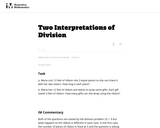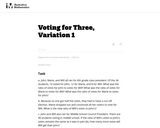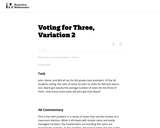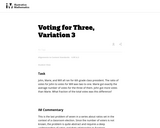
This task is from Tools for NC Teachers. Students solve multi-step word problems. This is remixable.
- Subject:
- Mathematics
- Material Type:
- Activity/Lab
- Formative Assessment
- Date Added:
- 07/13/2019

This task is from Tools for NC Teachers. Students solve multi-step word problems. This is remixable.

These Tasks are from Tools4NCTeachers. These Tasks align to 4.OA.3. They are remixable.

These examples of anchor charts are from Tools4NCTeachers. These anchor charts can be made by teachers to support Cluster 4, Grade 4. These are remixable.

This lesson is from Tools4NCTeachers. In this lesson, students use various strategies to solve division problems. This lesson is a good introductory lesson to dividing three-digit dividends by one-digit divisors. It allows the teacher to assess the strategies students use to solve division problems with larger numbers.

This lesson is from Tools4NCTeachers. In this lesson, students will apply their understanding of operations to distinguish and sort word problems based on which operation would correctly solve the problem. This is remixable.

This real world word problem about calculating a tip in a restaurant requires multiple steps.

These word problems about money require students to think in base 10.

Both of the questions in this task are solved by the division problem 12Ö3 but what happens to the ribbon is different in each case.

Two Step Word Problem Practice for Grade 3, Cluster 7

This problem is the fifth in a series of seven about ratios. In the first problem students define the simple ratios that exist among the three candidates. It opens an opportunity to introduce unit rates. The subsequent problems are more complex. In the second problem, students apply their understanding of ratios to combine two pools of voters to determine a new ratio. In the third problem, students apply a known ratio to a new, larger pool of voters to determine the number of votes that would be garnered.

This is the sixth problem in a series of seven that use the context of a classroom election. While it still deals with simple ratios and easily managed numbers, the mathematics surrounding the ratios are increasingly complex.

This is the last problem of seven in a series about ratios set in the context of a classroom election. Since the number of voters is not known, the problem is quite abstract and requires a deep understanding of ratios and their relationship to fractions.